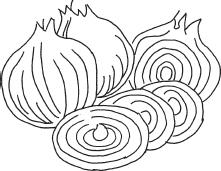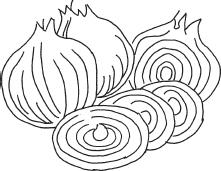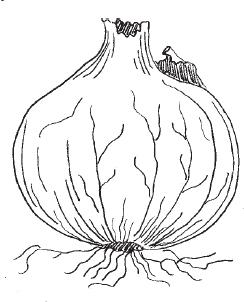Nourishing Traditions: The Cookbook That Challenges Politically Correct Nutrition and The... (109 page)
Authors: Sally Fallon,Pat Connolly,Phd. Mary G. Enig
Tags: #Non-Fiction, #Reference, #Science, #Health

Onions Chardonnay
Serves 4
6 medium or 4 large onions, peeled and very thinly sliced
1 cup dry Chardonnay wine
Place onions and wine in a pan. Bring to a boil, reduce and simmer, stirring occasionally, until most of the liquid has evaporated. This is a nice accompaniment to fish.
The onion species—a subset of the lily family—is ubiquitous, and no cuisine has developed that does not use the onion or one of its many cousins. They may have first been cultivated in Asia or India, but wild onions are native in many localities including North America. The Great Lakes Indians called them
She-khe-ony
, and it is from this Indian word that the city of Chicago derives its name. Onions are valued for their distinct flavor, which enhances the flavors of other ingredients in any dish; and they are a particularly good marriage with bland, starchy foods, such as legumes or potatoes.
Onions contain carotenoids, B complex vitamins—including all-important B
6
—and vitamin C, calcium, magnesium, potassium and sulphur compounds. They are universally valued for their medicinal properties, which include improvement of kidney function and antibacterial qualities. According to some researchers, half a cup of raw onions per day is an excellent means of protecting the blood from a tendency to coagulate and clot. Onions also have been shown to lower elevated blood sugar levels in test animals. Pasteur was the first to recognize that onions have strong antibacterial powers; onions are also helpful in breaking up mucus in the throat, lungs and nasal passages. Finally, recent research indicates that onions, with their concentrated sulphur compounds, can be useful in treating cancer in some people. Onions also concentrate germanium when it is found in the soil. Germanium acts as an oxygen transporter and has been useful in cancer therapy.

Baked Onions with Pecans
Serves 8
4 large onions, peeled
1 cup
chicken stock3 tablespoons butter
1 tablespoon honey
1 teaspoon grated lemon rind
¼ teaspoon paprika
sea salt
½ cup
crispy pecans
, finely chopped
Cut onions in half along the equator and place cut side up in a buttered glass baking dish. Mix stock, butter, honey, lemon rind, and paprika and heat gently until well blended. Season to taste. Pour over onions. Bake, covered, for about 50 minutes at 350 degrees, basting occasionally, until onions are just tender. Remove cover, sprinkle with pecans and bake another 10 or 15 minutes until lightly browned.
On the other hand, certain yogic diets prohibit the onion because it is said to "increase body heat and the appetites." This may be because the onion acts as a stimulant to the adrenal glands. Those with weak adrenal glands should eat of the onion family sparingly as should individuals sensitive to sulphur-containing foods.
To peel small onions, remove ends and plunge briefly into boiling water. Skins will then come off easily. SWF

Stuffed Onions
Serves 84 large onions
2 tablespoons extra virgin olive oil
1½ cups whole grain bread crumbs or
basic brown rice¼ cup
crispy pine nuts1 teaspoon dried oregano
¼ cup Parmesan cheese, grated
2 teaspoons parsley, finely chopped
1 egg, lightly beaten
sea salt and pepper
Cut onions in half along the equator and remove the inner part of the onion, leaving a shell two or three layers thick. Make a small slice on the bottom of each onion shell so that it will stand upright. Place shells in a buttered glass oven dish.
Chop the onion taken from the centers and saute in olive oil until tender. Add rice or bread crumbs, pine nuts, oregano, cheese and parsley and mix well. Remove from heat, stir in the egg and season to taste. Fill the onion shells with the stuffing. Add a little water to the baking pan and bake at 300 degrees for 1 hour.
One of your greatest difficulties will be to provide the children and yourselves with sufficient of the fat-soluble activators and vitamins. We, being mammals, have bodies prepared to get these from milk and its butterfat, which is not in skimmed milk. There is not much left for the children when the cream has been taken from the milk for the parents' coffee. Where possible, have June butter stored for winter use. Cod-liver oil can be given in moderate doses without injury and to great advantage. Seldom, however, should the child be given more than one teaspoonful a day for extended periods, because of toxic effects that often develop. It is better to take the cod-liver oil with the meal rather than before or after, as it aids in the utilization of the minerals in the food. Weston Price, DDS
Letter to His Nieces and Nephews
1934
Glazed Pearl Onions
Serves 6
30 pearl onions, peeled
1 tablespoon butter
1 tablespoon extra virgin olive oil
1 teaspoon honey
½ cup filtered water or
beef stock½ cup red wine vinegar (optional)
pinch of sea salt
To peel small onions, see sidebar,
Stuffed Onions
. Mix honey with stock or water and heat until honey is dissolved. Place onions, butter, oil, honey mixture and salt in a skillet large enough to accommodate the onions in one layer. Add the vinegar if you want a sour taste. Bring mixture to a boil, cover and cook a few minutes until the onions begin to soften. Remove lid from pan and continue cooking, stirring frequently, until liquid has evaporated and the onions become coated with glaze.
Scattered across the earth are people of vastly different races, cultures, body types, and belief systems. They live near mountains, oceans, rivers, deserts, tundra, tropics, forests and flatlands. Some have only fish and a few varieties of plants available to eat; some, an assortment of tropical fruits and vegetables; some have only yak milk, meat and a little grain; while others have enough fertile land and resources to raise crops, herd animals, and mass-produce every imaginable variety of food.
Is it sensible for any one people to tell another about the "true" ways to eat? Can a tribesman from West Africa whose staple food is cassava root tell an Eskimo he is wrong because his staple food is fish? Or can the Japanese tell the Mexicans of the absurdity of eating dairy, corn, hot peppers and food fried in lard, staple products completely unknown to native Japan? Marc David
Nourishing Wisdom
Onion-Cranberry Compote
Makes 4 cups
2
/
3
cup yellow raisins2
/
3
cup dark raisins1½ cups hot filtered water
2 pounds small white onions, peeled
4 tablespoons butter
¾ cup white wine vinegar
1 cup dry white wine
3 cloves garlic, peeled and minced
½ teaspoon dried thyme
1 teaspoon sea salt
1
2
/
3
cups fresh cranberries
This is an excellent substitute for sugary cranberry relish at Thanksgiving. To peel small onions, see sidebar,
Stuffed Onions
.Soak raisins in water for 10 minutes. Meanwhile, in a large saucepan, saute onions in butter until well coated. Add wine and vinegar and boil down for several minutes. Add raisins with soaking liquid and remaining ingredients except cranberries. Liquid should just cover the onions—if not, add a little water. Simmer, covered, for about 1 hour, stirring occasionally. Remove cover, add cranberries and simmer uncovered for 15 to 30 minutes until liquid has thickened. Let cool. May be made up to 3 days in advance and stored in the refrigerator. Serve at room temperature.
The cranberry grows wild in marshy places in New England and as far south as North Carolina. First called "fen berries" by the settlers, they were soon incorporated into their diets. Eventually the name changed to "craneberry" or "cranberry" because the slender stems of the fruit curve like the neck of a crane.
As early as 1860, medical science recognized the value of cranberries or their juice for the treatment of urinary tract infections and other kidney problems. Cranberries raise the level of acid in the urine and act as an antibiotic. SWF
PARSNIPS
The parsnip is a much maligned vegetable. When boiled in water, they are not very appetizing; but sauteed in butter they have a delicious taste and a nice texture. Remove ends, peel and cut into strips. Saute in butter until golden and just tender.
Parsnip Puree
Serves 6-8
1½ pounds parsnips, peeled and cut into 1-inch pieces
2 potatoes, baked (
Potatoes
)½ cup
piima cream
or
creme fraiche4 tablespoons butter, softened
1 teaspoon freshly grated ginger (optional)
pinch nutmeg
sea salt and pepper